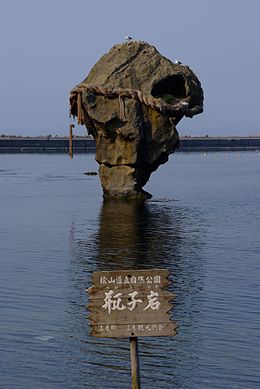Kamome Island
| Native name: 鷗島, Kamome Jima | |
|---|---|

Heishi Rock is an attraction at Kamome Island.(April 2007)
|
|
| Geography | |
| Location | East Asia |
| Coordinates | 41°52′04″N 140°06′51″E / 41.867781°N 140.1143°ECoordinates: 41°52′04″N 140°06′51″E / 41.867781°N 140.1143°E |
| Archipelago | Japanese archipelago |
| Coastline | 2.6 km (1.62 mi) |
| Highest elevation | 27.6 m (90.6 ft) |
| Highest point | Mount Kamui |
| Administration | |
|
Japan
|
|
| Prefectures | Hokkaidō |
| Subprefectures | Hiyama Subprefecture |
| District | Hiyama District |
Kamome Island (鷗島 Kamome Jima?) is an island (or more precisely, peninsula) in the Sea of Japan just off the coast of the town of Esashi, Hokkaidō, Japan. The island serves as a breakwater for the Esashi port. It has several historical sites and is protected as a part of the Hiyama Prefectural Natural Park. Every July, there is a two-day festival that attracts tourists to the island. People visit the island throughout the year for swimming, camping, fishing and other recreational activities.
Kamome Island is part of the coastal terrace, being mostly flat. It rises just 27.6 meters (91 ft) above sea level. The island has a width of about 200 meters (660 ft), a length of about 1 kilometer (0.62 mi) and a coastline of 2.6 kilometers (1.6 mi). It is connected with the mainland by a 500 meters (1,600 ft) long sandbank and thus is accessible by road. As the island stretches roughly from north to south and the mainland lies to the east, the island naturally serves as a coastal protection from sea waves. An additional wave breaker line was built to extend this protection to the north. However, the western coast of the island is severely eroded by the waves.
The island once served as a natural port for Edo period ships trading with Hokkaidō or for fishermen seeking to catch Pacific Herring.
The herring fishery is also reflected in the legend of the Heishi rock. This 500-year-old legend says that once when herring vanished, an old woman (a fortune teller) was given a bottle with magic liquid. She threw the bottle into the sea and the herring returned. The bottle stuck to the seabed and turned into a rock, which became a representation of the god of the Sea of Japan.
In 1615, a group of merchants raised a shrine on the island to honor the god of the Sea of Japan, and in 1868 it was renamed into Itsukushima Shrine. In 1814, a monument to Matsuo Bashō, the most famous poet of the Edo period in Japan, was installed near the shrine.
...
Wikipedia
